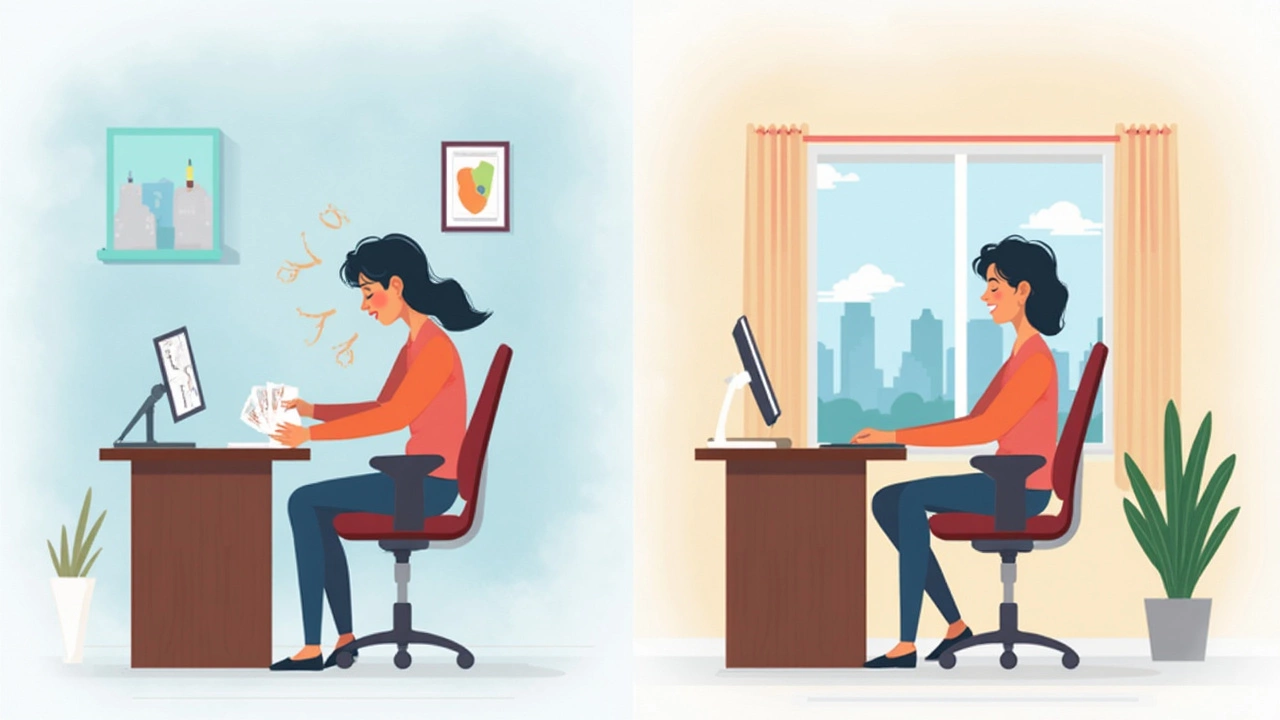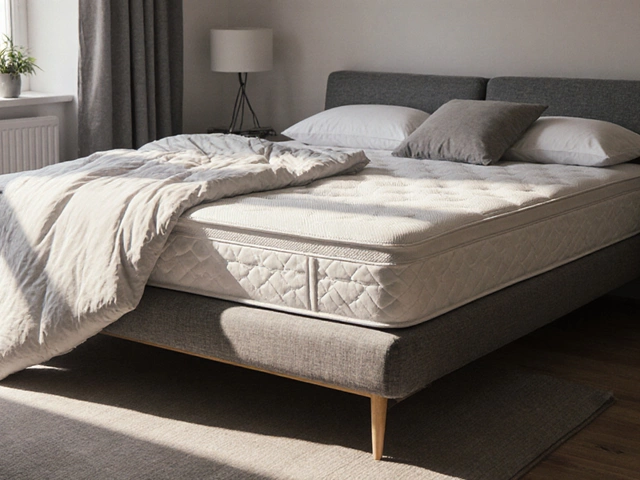 1
Jul,2025
1
Jul,2025
Imagine sitting at your desk, ready to tackle your task list, but something feels off. You keep fidgeting, your legs are dangling, your shoulders are tense, and no matter how much you adjust, it just feels wrong. That weird, almost awkward discomfort? It could all boil down to one thing: your office chair is too high. Not many people realize how dramatically this one simple mistake can mess up your workday, your energy, and even your long-term health.
Why Office Chair Height Matters More Than You Think
We often underestimate the humble chair. You just sit on it, right? Here’s the kicker: the way your chair aligns your body can mean the difference between powering through your day and limping through it. Let’s talk about why chair height is one of the most important—and most ignored—aspects of office comfort.
If your chair is too high, it throws your whole posture out of whack. Your feet hang, there’s pressure under your thighs, your arms hover above the desk, and your whole upper body starts slumping forward. Over hours or weeks, that can add up to real pain. Studies from the ergonomics experts at Cornell University confirm that bad chair height can increase your risk of musculoskeletal trouble—think tense shoulders, lower back pain, and even tingling in your legs.
The ideal chair height puts your feet flat on the floor, your knees level with your hips (or just slightly below), and your elbows at about a 90-degree angle when you rest your arms on your desk. Easy to remember, right? But tons of people ignore these basics and pay the price with fatigue and pain that just keep piling up. Even that fancy gaming chair or cushy executive seat won’t save you if it’s set too high for your legs.
What Goes Wrong When Your Chair is Too High?
You might not notice the damage right away, but over time, sitting in an oversized desk chair really messes with your body. Let’s unpack what exactly can (and usually does) go wrong:
- Circulation problems: When your feet can’t touch the ground, the edge of your chair presses against the back of your thighs, cutting off blood flow. According to a 2023 study in the Journal of Occupational Health, this can cause anything from pins and needles to swollen ankles and even varicose veins.
- Lousy posture: If your arms have to reach up to your desk, your shoulders tense and your back rounds. It doesn’t take long before you start feeling tight knots around your shoulder blades and neck. A study by the National Institutes of Health even linked incorrect chair height to a 60% rise in reported back pain among office workers.
- Dangling feet, unhappy knees: Your legs want to rest on something. If they’re dangling, your knees lose their natural support, making them ache after a while. That’s why people often feel more tired or even restless after sitting in a chair that’s too high.
- Hunched typing, bad wrist angles: To reach your keyboard and mouse, you probably scrunch your shoulders and cock your wrists up at awkward angles. Over time, this increases your risk for carpal tunnel syndrome and other nasty repetitive strain injuries. Fact: Stanford University found that improper chair-to-desk height nearly doubles your risk for wrist pain.
- Mental fatigue: Feeling uncomfortable, tense, or constantly shifting position eats away at your focus. Ever notice how your productivity goes down when you’re distracted by aches and awkward seating? There’s a reason for that—when your body protests, your mind just can’t zero in on your work.
Here’s a table highlighting just how much of a difference bad chair height makes. These are average increases in symptoms, based on recent office worker health surveys from 2022:
| Problem | Increase (%) With Chair Too High |
|---|---|
| Back pain | 63% |
| Shoulder tension | 54% |
| Circulation issues | 71% |
| Wrist pain | 49% |
| Mental fatigue | 46% |
So if you find yourself shuffling endlessly at your desk, it’s not just you “getting old” or “weak.” Your chair’s height might just be sabotaging your day, every single day.

The Surprising Ripple Effect on Productivity and Mood
You ever have those days where you’re just grumpy for no reason? Or maybe it’s the third time you’ve forgotten a password or blanked out on a task you do every day. Small annoyances at work can actually snowball into much bigger problems. And believe it or not, a too-tall chair often sets off this whole chain reaction.
Here’s how: when you’re uncomfortable, your body constantly demands attention. That can make you irritable and, according to a 2023 survey by the International Well Building Institute, it can lower your work output by as much as 15%. That’s the productivity equivalent of losing a couple of hours every day.
Poor posture and discomfort from bad chair height can also impact your breathing and circulation, which affects oxygen getting to your brain. Less oxygen means less energy and more sluggish thinking. If you’re starting to yawn or drift off in the afternoons, your chair could be part of the problem. Even Lucy, my spouse, once noticed I was snappier than usual during a stressful work week. Turns out, I had raised my chair without thinking. Fixed that, and suddenly my days felt a lot smoother.
This isn’t just a bunch of ergonomic wonk talk either. Psychologists have measured the link between physical comfort and mood, especially for remote workers and office staff who spend more than six hours sitting per day. One peer-reviewed study from 2024 even found users with poorly fitted chairs reported almost 50% higher stress levels than those in properly adjusted workstations. Don’t let a chair mess with your brain chemistry or your vibe at work—it’s such an easy fix once you spot it.
Simple Fixes for a Chair That’s Too High
So what do you actually do if you realize your chair is way too tall, but you’re stuck with it? Not everyone can just buy a new chair or get a fancy standing desk overnight. Good news—most problems have a quick fix if you know where to look.
- Lower your chair: This one’s obvious if your chair has adjustable height. Make sure when you sit, your feet are flat on the floor, knees bent around 90 degrees, and elbows also at 90 degrees when you type.
- Add a footrest: If lowering your chair means your arms are now too low for your desk, stick a footrest (or even a sturdy box) under your feet. This puts your legs at the right angle and protects your circulation. Cheap, effective, and makes a huge difference.
- Check your desk height: Sometimes offices skimp on adjustable desks. The trick? Stack your keyboard and mouse on a big book or slim platform, so you don’t need to reach up. Keeping your elbows close to 90 degrees makes hours of typing way less taxing.
- Add a chair cushion strategically: Caution here—you don’t want to go higher, but sometimes a lumbar pillow can help your posture. Just make sure it’s not making your seat taller.
- Short people problems? A lot of jobs hand out the same chairs to everyone, but not everyone is the same height. If your feet can’t quite reach the floor, get creative: a thick foam pad works, even rolled-up yoga mats, or those old phone books (if anyone still has them!).
- Monitor your body: If you feel numbness, aching, or tingling, or if you’re constantly uncomfortable—don’t ignore it. Change things up right away. Your body usually knows before your brain figures out what’s wrong.
If you’re unsure exactly what height is perfect for you, here’s a quick reference table. It’s not an exact science, but it gives you a decent start:
| Your Height (cm) | Ideal Chair Height (cm, from floor to seat) |
|---|---|
| 150-160 | 38-42 |
| 161-170 | 42-46 |
| 171-180 | 45-50 |
| 181-190 | 48-53 |
Most modern office chairs max out around 55 cm, but many people work best with the seat closer to 42-47 cm. Check your user manual—the adjustment lever is usually right under your seat’s left or right edge.

How to Set Up Your Workspace for Perfect Comfort
Fixing your chair height is the most important step, but your comfort doesn’t end there. Your whole workspace matters. If you really want to dial in some next-level comfort and lower your odds of aches or fatigue, here’s a step-by-step blueprint. This is what professional ergonomists recommend (and what I insisted on after leaking into my evenings full of backaches):
- Sit all the way back in your chair with your back supported by the backrest.
- Adjust your chair height until your feet are flat on the floor, knees at about a 90-degree angle.
- Check if your knees are slightly lower than your hips (ideal) or at most level with them. If your chair is too high, use a footrest to achieve this.
- Rest your arms comfortably at your sides. When you use your keyboard, your elbows should also bend close to 90 degrees. Raise or lower your desk OR your chair/footrest combo to get here.
- Your monitor should sit directly in front of you, with the top third at or just below eye level. This keeps you from leaning or hunching.
- Keep your mouse close. Avoid overreaching—injuries often start this way.
- If you use a laptop, prop it up to eye level and use a separate keyboard and mouse. Laptops on their own are almost impossible to use ergonomically without a bunch of discomfort over months.
- Take breaks! No chair or setup can offset damage from hours of sitting still. Try the “20-8-2” rule: sit for 20 minutes, stand and stretch for 8, move around for 2.
If you work at home, don’t try to power through on a barstool at the kitchen counter. Even if you have to improvise, your future self will thank you. The best secret? Spot issues fast and tweak your setup until it feels just right. If you catch yourself shifting around too much or ending the day sore, check your chair first—it’s usually the culprit.
Remember, one small adjustment can save you a lot of pain and wasted energy. Listen to your body. Your comfort isn’t a luxury; it’s how you unlock more productive, happier workdays—wherever and however you work.




